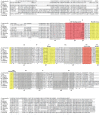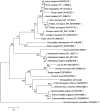Toward understanding the functional role of Ss-RIOK-1, a RIO protein kinase-encoding gene of Strongyloides stercoralis
- PMID: 25101874
- PMCID: PMC4125297
- DOI: 10.1371/journal.pntd.0003062
Toward understanding the functional role of Ss-RIOK-1, a RIO protein kinase-encoding gene of Strongyloides stercoralis
Abstract
Background: Some studies of Saccharomyces cerevisiae and mammals have shown that RIO protein kinases (RIOKs) are involved in ribosome biogenesis, cell cycle progression and development. However, there is a paucity of information on their functions in parasitic nematodes. We aimed to investigate the function of RIOK-1 encoding gene from Strongyloides stercoralis, a nematode parasitizing humans and dogs.
Methodology/principal findings: The RIOK-1 protein-encoding gene Ss-riok-1 was characterized from S. stercoralis. The full-length cDNA, gDNA and putative promoter region of Ss-riok-1 were isolated and sequenced. The cDNA comprises 1,828 bp, including a 377 bp 5'-UTR, a 17 bp 3'-UTR and a 1,434 bp ORF encoding a protein of 477 amino acids containing a RIOK-1 signature motif. The genomic sequence of the Ss-riok-1 coding region is 1,636 bp in length and has three exons and two introns. The putative promoter region comprises 4,280 bp and contains conserved promoter elements, including four CAAT boxes, 12 GATA boxes, eight E-boxes (CANNTG) and 38 TATA boxes. The Ss-riok-1 gene is transcribed throughout all developmental stages with the highest transcript abundance in the infective third-stage larva (iL3). Recombinant Ss-RIOK-1 is an active kinase, capable of both phosphorylation and auto-phosphorylation. Patterns of transcriptional reporter expression in transgenic S. stercoralis larvae indicated that Ss-RIOK-1 is expressed in neurons of the head, body and tail as well as in pharynx and hypodermis.
Conclusions/significance: The characterization of the molecular and the temporal and spatial expression patterns of the encoding gene provide first clues as to functions of RIOKs in the biological processes of parasitic nematodes.
Conflict of interest statement
The authors have declared that no competing interests exist.
Figures







References
-
- Igra-Siegman Y, Kapila R, Sen P, Kaminski ZC, Louria DB (1981) Syndrome of hyperinfection with Strongyloides stercoralis . Rev Infect Dis 3: 397–407. - PubMed
-
- Schad G (1989) Morphology and life history of Strongyloides stercoralis. Strongyloidiasis: a major roundworm infection of man. Philadelphia: Taylor & Francis 85–104.
-
- Hanks SK, Quinn AM, Hunter T (1988) The protein kinase family: conserved features and deduced phylogeny of the catalytic domains. Science 241: 42–52. - PubMed
-
- Manning G, Whyte DB, Martinez R, Hunter T, Sudarsanam S (2002) The protein kinase complement of the human genome. Science 298: 1912–1934. - PubMed
Publication types
MeSH terms
Substances
Grants and funding
LinkOut - more resources
Full Text Sources
Other Literature Sources

